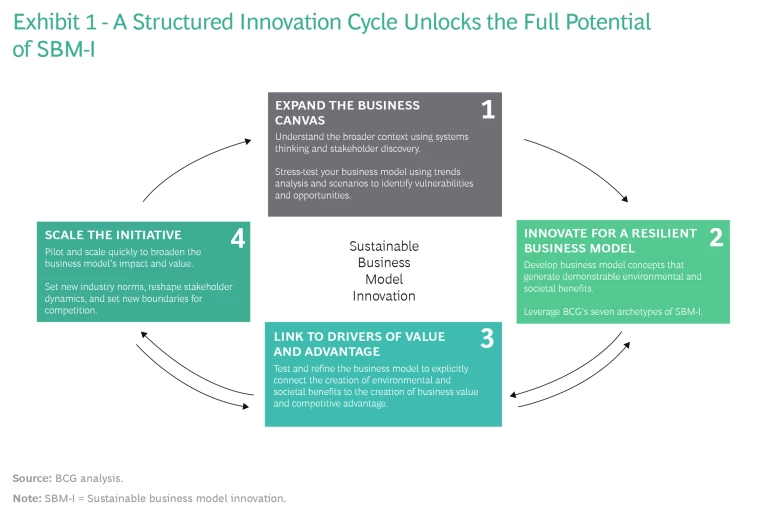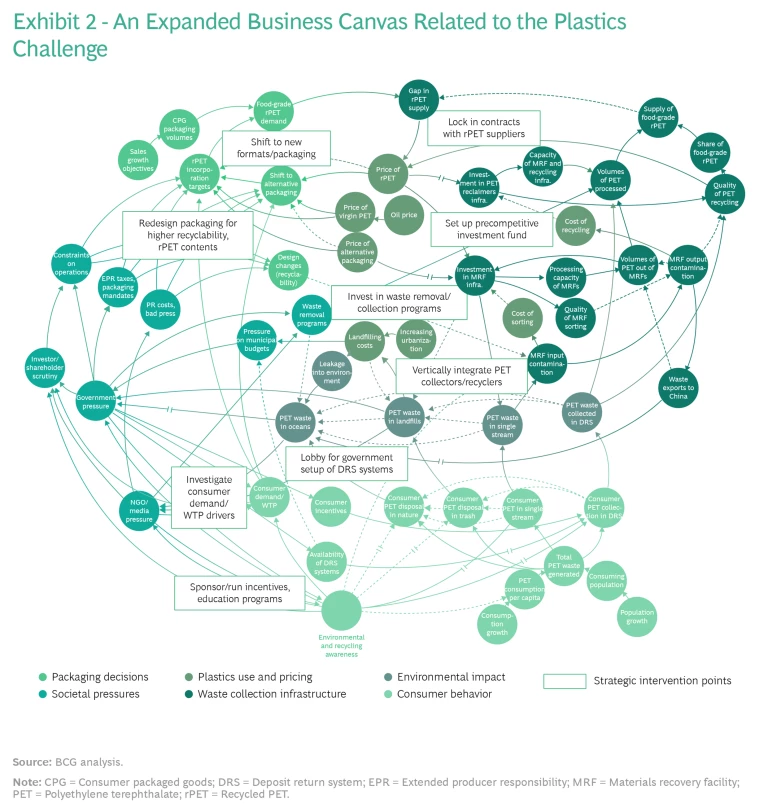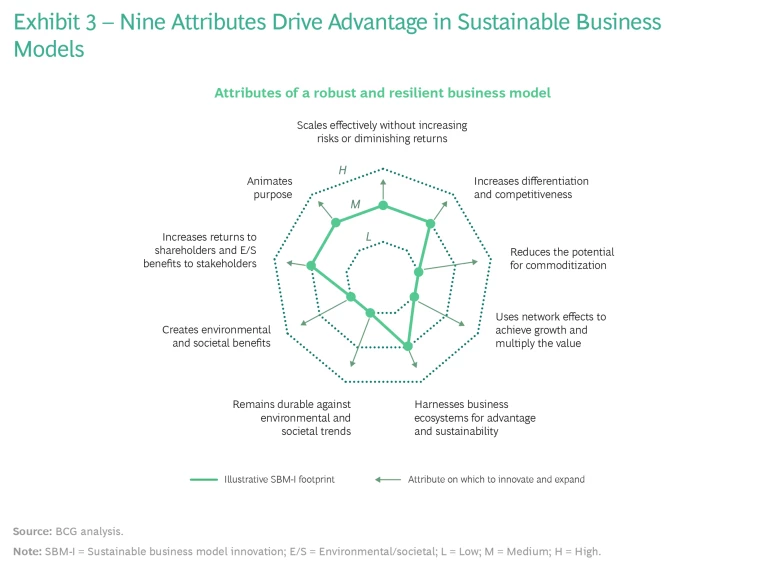This article is part of an ongoing series that describes the concept of “Sustainable Business Model Innovation” (SBM-I) and how companies are putting it to use.
You may have noticed that every day there’s another announcement about companies making new climate commitments, asset managers outlining their plans for ESG integration, or regulators proposing new disclosures or extending producers’ responsibilities. Corporate coalitions like the World Economic Forum International Business Council and the US Business Roundtable endorse a more stakeholder-inclusive corporate capitalism while industry coalitions work to solve their members’ shared sustainability challenges. And employees and consumers call on employers and brands to take environmental and social challenges seriously. All of this makes clear that we have entered a new era for business, one in which sustaining competitive advantage requires companies to transform their business models for sustainability.
Company leaders need a broader, more systemic understanding of these dynamic sustainability challenges and the ways that their companies can play a part in addressing them. Fortunately, as some farsighted businesses are discovering, the most powerful opportunities for profitable innovation are embedded in these same challenges. Let’s consider three examples.
The first is Telenor, the leading Norwegian mobile operator. In 2008, having entered Pakistan three years earlier, it joined forces with the microfinance bank Tameer. With support from the Bill and Melinda Gates Foundation, the International Finance Corporation (IFC), and the Consultative Group to Assist the Poor (CGAP), they launched a new service called Easypaisa, providing mobile-based financial services to the unbanked and underbanked. By the end of 2019, Telenor Microfinance Bank (the result of Telenor’s acquisition of Tameer) boasted the largest branchless banking service in Pakistan, growing its Easypaisa mobile wallet user base to 6.4 million, its depositor base to 17 million, and the transactions volume through its agent network to about PKR 1 trillion (approximately $6 billion). This service has significantly advanced financial inclusion in Pakistan and established Telenor as a major telecom enterprise there.
To maintain competitive advantage, companies must transform their business models for sustainability.
Or consider Ajinomoto, a global food and biotech company based in Japan. It produces seasonings, sweeteners, and pharmaceuticals. As part of its 2030 vision and growth strategy to “help one billion people worldwide lead a healthier life,” Ajinomoto is exploring a new "personalized nutrition for health" business. Combining its core nutrition expertise and new technology, the company aims to provide customers with digitally enabled diagnostics, analytics, and product recommendations. These would guide people toward the kind of well-balanced amino acid intake that boosts cognitive and physiological functions and helps prevent aging-related diseases like dementia—a prominent societal issue in Japan.
Another example is Indigo Ag, a US-based agricultural technology startup that was valued at $1.4 billion in 2017. In 2019, the company launched a service called Indigo Carbon to help incentivize farmers to remove carbon from the atmosphere and sequester it in their soil. The service provides technologies and recommendations for regenerative agriculture practices. The ultimate goal is to pay farmers for each ton of carbon captured and then sell certifications to companies looking to offset their carbon footprints. By supporting a transparent carbon credit marketplace, Indigo Carbon creates benefits for all participants: the farmers, the companies buying the offsets, the planet, and its own business.
What do these three companies have in common? Regardless of industry, geography, or size, they (and dozens of others like them) are innovating business models—building on and expanding beyond their core assets and capabilities—to address significant environmental and societal challenges in their local contexts. In this way, they create new sources of value and competitive advantage for their business.
The Four-Step Innovation Cycle
In our research, we have studied more than 100 cases of companies that are practicing what we call “Sustainable Business Model Innovation” (SBM-I). We have found that the most advanced of these companies, the “front-runners,” combine environmental, societal, and financial priorities to re-imagine their core business models and even shift the boundaries of competition.
One might expect the front-runners to consist mainly of smaller enterprises, branded through their visible social or environmental missions. But most of them are actually global corporations that have gradually developed new business models that create both sustainability and long-term competitive advantage.
The core practice for SBM-I is an iterative innovation cycle, shown in Exhibit 1. With each round, the company gains scale, experience, and market presence for its initiative; these reinforce both the business advantage and the environmental and societal benefits generated.

1. Expand the Business Canvas
So how can you bring this cycle to life in your company? The first step is to develop a rich understanding of the broader stakeholder ecosystem in which the company operates and of the environmental and societal issues and trends that might affect this ecosystem. As part of this diagnosis, you explore the potential impacts of ecosystem dynamics and issues on your business model. This will allow you to identify a range of business vulnerabilities and opportunities tied to environmental and societal issues. Some of these are good starting points for focused SBM-I.
More specifically, we recommend the following:
- Expand the business canvas by mapping the wider ecosystem of stakeholders and societal issues in which the business operates. Ask yourself: Who are the key stakeholders in the system? What are the material environmental and societal issues and trends? How do stakeholders and environmental and societal issues directly or indirectly impact all the different parts of the business model?
- Stress-test the business model (current or potential) within this broader map. How do stakeholder dynamics and environmental and societal issues constrain or hold back your business model? Where do limitations in the system create vulnerabilities for the business model?
- Extrapolate trends and build materiality scenarios. Look at today’s environmental and societal trends and think about how they might evolve over time. In addition, build scenarios to envision completely different, more extreme versions of the future (as opposed to linearly projecting trends) to stretch your thinking. And then, under these scenarios, ask yourself: How might environmental and societal issues change over time? How might stakeholders’ perceptions of and attitudes toward those issues shift? What would be the effects on the system map and the business model?
- Explore scaling up the business. Imagine the business model at different scales of activity. Suppose your business grew three- or five-fold over the next few years. Where might breaking points or opportunities arise? What happens to the externalities the business creates? How do risks and opportunities change?
- Identify innovation opportunity spaces or “strategic intervention points” (SIPs). These are points at which targeted action or innovation could alter stakeholder dynamics, positively impact the environmental or societal issues, reduce the vulnerabilities of the business model, or even create new business value opportunities.
Look for difficulties, gaps, and risks to arise from the analysis. For example, your company’s own lines of business might contribute to the environmental or societal issue and impact the growth of the business today. Also, don’t just rely on your own thinking. Cultivate outsiders who can provide complementary and thought-provoking perspectives.
In a recent interview , Christine Rodwell, former vice president of business development cities at Veolia, explained that “to walk the talk on sustainability, companies need to listen to their external stakeholders. They should create a committee of critical friends (across public, social, and academic sectors) who will challenge them and advise them to develop business solutions that create meaningful environmental and societal benefits.”
To understand what expanding a business canvas looks like in practice, consider the hypothetical example of a consumer packaged goods (CPG) manufacturing company engaged in a real-world dilemma: the toxic effect of plastic packaging on natural habitats, particularly in the world’s oceans. About 18 billion pounds of plastic waste enter the world’s oceans each year. This is equivalent to five grocery bags of trash on every foot of coastline. Plastic pollution causes extensive damage to life on land and at sea, including toxic contamination, strangulation, blockage of digestive passages, and endocrine-related reproductive problems for people as well as animals. Concerns about this problem reached a tipping point in the mid-2010s, as studies confirmed the damage.
As industrial leaders in this field know all too well, the complexities of gathering, cleaning, sorting, recycling, and reusing plastics have made it costly and difficult to address this issue. Companies that step forward with effective and financially viable solutions will not only gain enormous goodwill but are also likely to build high-growth businesses.
But where do you start? And where do you focus innovation efforts and investments to tackle such a complex, multifaceted environmental issue? Reflecting the SBM-I cycle approach, Exhibit 2 shows what a stakeholder-centric systems map for the plastics issue could look like from the point of view of a CPG company. This map uses basic systems dynamics principles to capture the most significant interrelationships among the CPG company, the environmental issue at stake, and key stakeholders (consumers, policymakers, civil society, waste collectors and recyclers, and plastics manufacturers). The arrows show patterns of cause and effect. For example, when urbanization increases, so does the cost of landfilling.

The power of this diagram (versus more traditional, linear depictions) comes in part from its ability to reveal where delays, rebound effects, or tipping points might be active in the system. For instance, the node labeled “environmental and recycling awareness” will influence changes in several consumer habits—but only after a delay. Such awareness cannot be seen as a quick-fix solution, but over time it will help change the dynamics of the entire system.
Companies that bring viable solutions to the plastics problem will gain enormous goodwill and likely build high-growth businesses.
The boxes in the exhibit represent the opportunity spaces or strategic intervention points (SIPs) that become evident during this step. In this example, a few of the SIPs for our CPG company are as follows: shifting to new packaging formats; setting up plastic collection initiatives; lobbying for government programs like deposit return systems; joining precompetitive coalitions that invest in recycling infrastructure and new recycling technology; and educating and nudging consumers to consume and dispose of packaging in more sustainable ways.
2. Innovate for a Resilient Business Model
The first step in the cycle will have led you to identify the opportunity spaces that hold potential for both financial returns and societal value. You must then transform your business model, or imagine an entirely new one, so that you can seize these opportunities. In this second step, you innovate and develop new aspects of that new business model. You are seeking to bypass current constraints, break tradeoffs, deploy technological advances, and perhaps integrate activities that were previously kept separate. You should ideate a new business model to integrate and reinforce both business advantage and environmental and societal benefits.
In related research , we introduced and defined seven archetypal business models that optimize for both societal and business value. Here we illustrate how they might apply to the plastics waste challenge.
- Own the origins. Change production inputs to generate societal and environmental benefits. For instance, HP is working with waste collectors in a partnership with the First Mile Coalition in Haiti. HP has invested $2 million in a local facility to produce clean, high-quality recycled plastics that can then be used as input in an array of HP personal computer products and ink cartridges, reducing the environmental footprint of those products. Four years after its launch in 2016, the program had already diverted approximately 1.7 million pounds (771 metric tons) of plastic materials (equivalent to more than 60 million plastic bottles) from waterways and oceans and created income opportunities for 1,100 Haitians (with 1,000 more expected in coming years). Thanks to this and other efforts, HP boasted the world’s most sustainable PC portfolio in May 2020. This included, for example, the HP Elite Dragonfly, the first PC manufactured with ocean-bound plastic.
- Own the whole cycle. Create environmental and societal impact by influencing the product usage cycle from cradle to grave. Since the 1990s, Grupo AlEn, a leader in home cleaning products based in Monterrey, has invested and scaled up its in-house plastic recycling operations to become one of the largest plastic recyclers in Mexico. AlEn now operates 30 routes and 6,200 collection points in the Monterrey area, recycling more than 50,000 tons of PET and HDPE per year. This business expansion has given AlEn an exclusive supply of recycled plastics, enabling it to create distinctive, greener packaging at a relatively stable cost.
- Expand societal value. Expand the environmental and societal value of products and services, and capture value in pricing, market share, and loyalty. In 2018, PepsiCo acquired Sodastream, the world’s leading at-home sparkling water maker. Building on this technology, PepsiCo has begun to bring packaging-free, customizable beverages to workplaces, college campuses, and airports. This new business positions PepsiCo to win in the increasingly personalized beverage market and to save an estimated 67 billion single-use plastic bottles by 2025.
- Expand the value chains. Innovate by layering onto the business ecosystems of customers or of partners in other industries. In Chile, Algramo’s innovative bulk distribution system replaces single-use plastic with RFID-equipped reusable containers. Since 2013, the startup has scaled up its business by partnering with more than 2,000 family-owned stores across Santiago. They dispense affordable food and staple products “al gramo” (Spanish for “by the gram”) and reward customers for reusing containers. Algramo’s model not only helps the environment but also benefits the urban poor, who previously had to pay high prices for small quantities of products, in wasteful, individually wrapped packets.
- Re-localize and regionalize. Shorten and reconfigure global value chains to bring societal benefits closer to home. In Brazil, BASF has developed a solution to a local issue: waste certificate fraud. Some collectors and recyclers claim credits for recycled materials that they didn’t actually process or that aren’t actually recycled. Partnering with Kryha, a digital blockchain studio, and Recicleiros, an NGO that supports waste collectors and their cooperatives, BASF developed an online platform called ReciChain. This platform enables accurate and secured data tracking throughout the recycling value chain, to improve the quality of operations and guarantee the validity of manufacturers’ certificates and claims.
- Energize the brand. Encode, promote, and monetize the full environmental and societal value of products and services, and use that leverage to engage customers in novel ways. The innovative manufacturing company 3M released the latest version of its Thinsulate insulation product in 2019. This is “100% recycled featherless insulation” made from recycled plastic bottles. Building on this accomplishment, 3M worked with the high-end apparel brand Askov Finlayson to create “the world’s first climate-positive parka,” producing 3,000 parkas in 2019 as an inspiring demonstration project.
- Build across sectors. Create new business models in collaboration with government and nonprofit organizations, particularly in rapidly developing economies, to improve the business ecosystem and societal proposition. Together, SC Johnson and the social enterprise Plastic Bank have opened nine recycling centers in Indonesia to collect and recycle plastic before it reaches the ocean. This partnership also plays an important societal role, helping families in impoverished areas who collect plastic waste by buying it at a premium from them. In 2019, the partnership announced a ground-breaking, three-year deal to create 509 plastic collection points, including locations in Thailand, the Philippines, Vietnam, and Brazil. In aggregate, these points are expected to collect 30,000 metric tons of plastic over three years—the equivalent of stopping 1.5 billion plastic bottles from entering waterways and the ocean. On the business side, among other benefits, this collaboration will secure a steady supply of high-quality recycled plastics and help SC Johnson meet its 2025 packaging goals.
BCG Henderson Institute Newsletter: Insights that are shaping business thinking.
These seven archetypes can be starting points for developing your own business model innovation. Adapt them, and combine several together to develop a more comprehensive solution to environmental and societal issues relevant to your enterprise. Interestingly, among the 102 in-depth SBM-I cases that we explored in our research, 75% of the SBM-I leaders (the “front-runners”) combine three or more archetypes. This contrasts with less than 30% in the two other groups: the “ecosystem leaders” and the “initiative leaders,” whose efforts tend to be more narrowly focused.
In addition to exploring the possibilities inherent in these seven archetypes, take inspiration in the lessons learned from SBM-I front-runners. Front-runners see sustainability as a source of competitive advantage. In line with their long-term strategies, they continuously iterate and fine-tune their business models, always seeking to deepen their beneficial impact. They explicitly seek to understand and fix the root causes of environmental and societal challenges—as some of our plastics recyclers did, addressing not just the environmental concerns but also the social aspects of the issue. These companies also use digital technologies wherever possible, to break economic constraints and unlock new solutions. They practice an intensive form of stakeholder engagement: partnering with nonprofits and governments, operating across organizational boundaries, and pooling resources with other enterprises, even competitors. Last but not least, they experiment with new forms of value capture, such as blended financing sources, to de-risk and amplify their own investments. After all, notwithstanding their environmental and social track records, the front-runners are still in business to show a profit and return investment to shareholders.
3. Link to Drivers of Value and Competitive Advantage
In the third stage of the cycle, test, iterate, and refine your business model ideas or concepts (from the second step) to ensure that they will yield the environmental and societal benefits intended, and that the benefits will translate into value and advantage for the company. A business with weak profit margins cannot invest in innovation to amplify and scale environmental and societal benefits.
The objective of this step is to keep assessing and reengineering the business model, so that it continually improves the resilience of the business and the benefits to society. The following questions, based on our research into the characteristics of robust, resilient business models , can help you navigate this part of the process:
- Can the business model scale effectively? Can it be replicated across all your business units or the markets you serve, without diminishing returns?
- Will the business model differentiate your brand or product and make it more competitive in the marketplace?
- Will it reduce the risk of commoditization, by being hard for others to imitate? Will its distinctiveness help you retain some control over pricing?
- Can it leverage network effects? For example, can it attract the kinds of customers and suppliers that make other customers feel compelled to join?
- Does the business model harness business ecosystems—including the larger industry, the value chain, and everyone who interacts with your products, services, and practices—for advantage and sustainability?
- Does the business model naturally create meaningful environmental and societal benefits?
- Will the environmental and societal benefits remain durable against changing trends over time, even as the business model scales up?
- Does the business model increase returns to shareholders as well? Are the financial benefits linked to the environmental and societal benefits in some significant way?
- Finally, does the model animate your company’s purpose? Does it boost engagement and loyalty between the company and its employees, customers, investors, and other stakeholders?
Exhibit 3 shows how a company might assess its business model against these nine questions. The resulting footprint reveals how robust and resilient the business model is and identifies where it could be improved to unlock further advantage and value for the company.

The fuller the footprint, the better. Among the front-runners in our sample, 90% score “high” on at least five of the nine attributes, as opposed to only 30% in the other groups. The front-runners also show superior average scores on every single dimension.
4. Scale the Initiative
The full potential value of sustainable business model innovation is achieved only when the new business model is brought to scale: engaging people in the company, across the supply chain, in the company’s networks, and in its ecosystems to expand impact and advantage.
To accomplish this, companies can leverage three enablers. First, partnerships with other organizations, within or across industries or sectors, can help a company pool resources, fill capability gaps, and unlock new markets. Almost 90% of the front-runners have broadened their efforts this way. Second, digital technology (leveraged by 80% of the front-runners) can help create new distribution channels that reach previously unserved or underserved populations at a fraction of the cost of their predecessors. Third, companies that adopt SBM-I tend to develop cultures and leadership values that attract and engage people inside and outside their boundaries. Indeed, all of the front-runners explicitly mention the environmental and societal impact they seek to deliver in their vision, purpose, or mission statements.
Consider the example of BIMA, a mission-driven provider of mobile-delivered health and insurance services that started operations in Ghana in 2010. Its innovative digital technology platform and its partnership model (which comprises telecom providers, mobile money providers, and insurance underwriters) have enabled it to rapidly scale its innovative business model. BIMA now provides affordable, easy-to-manage life and health insurance to more than 35 million low-income customers across ten emerging economies. BIMA’s customers have access to its services through their mobile phones. Many of them are lower income families who earn less than $10 a day. About 75% of them are obtaining insurance for the first time in their lives. These societal benefits are at the core of BIMA’s strategy and mission; the company’s website says explicitly that its “purpose is to protect the future of every family.”
The four-step innovation cycle we propose in this article offers companies a way to systematically integrate and solve for social and business value in one business model. Most of the companies that begin this journey are already skilled at optimizing for business advantage. They may already recognize the importance of taking into account their environmental and societal impacts. With this approach, they are now ready to take on innovation for a business that optimizes for both business and social value.






